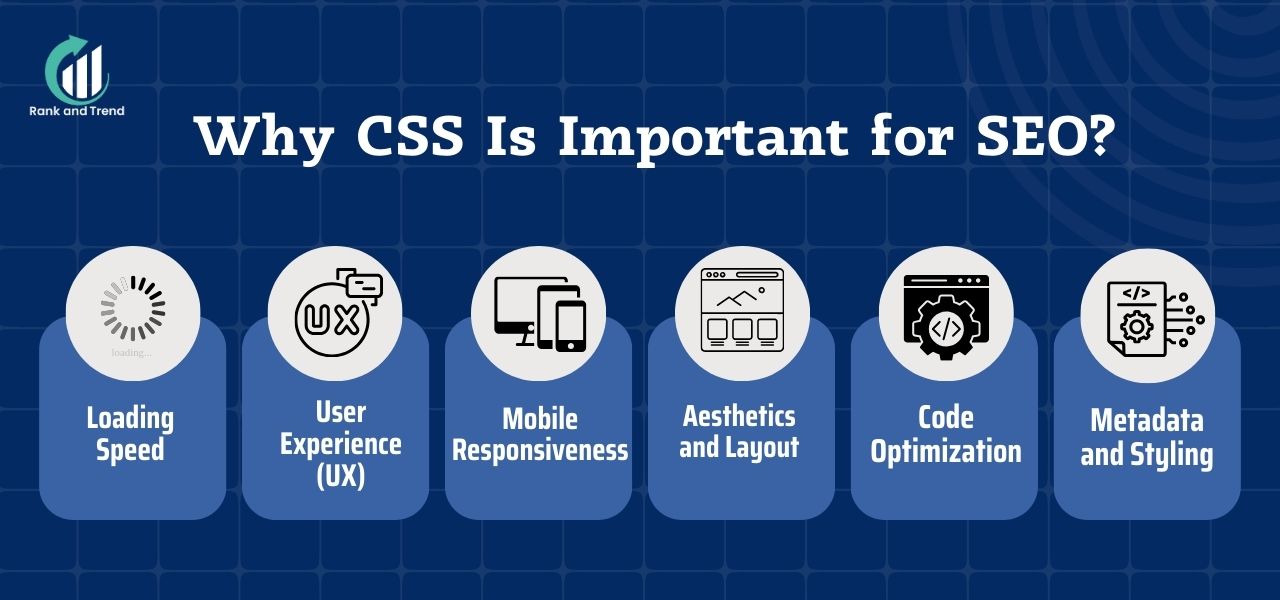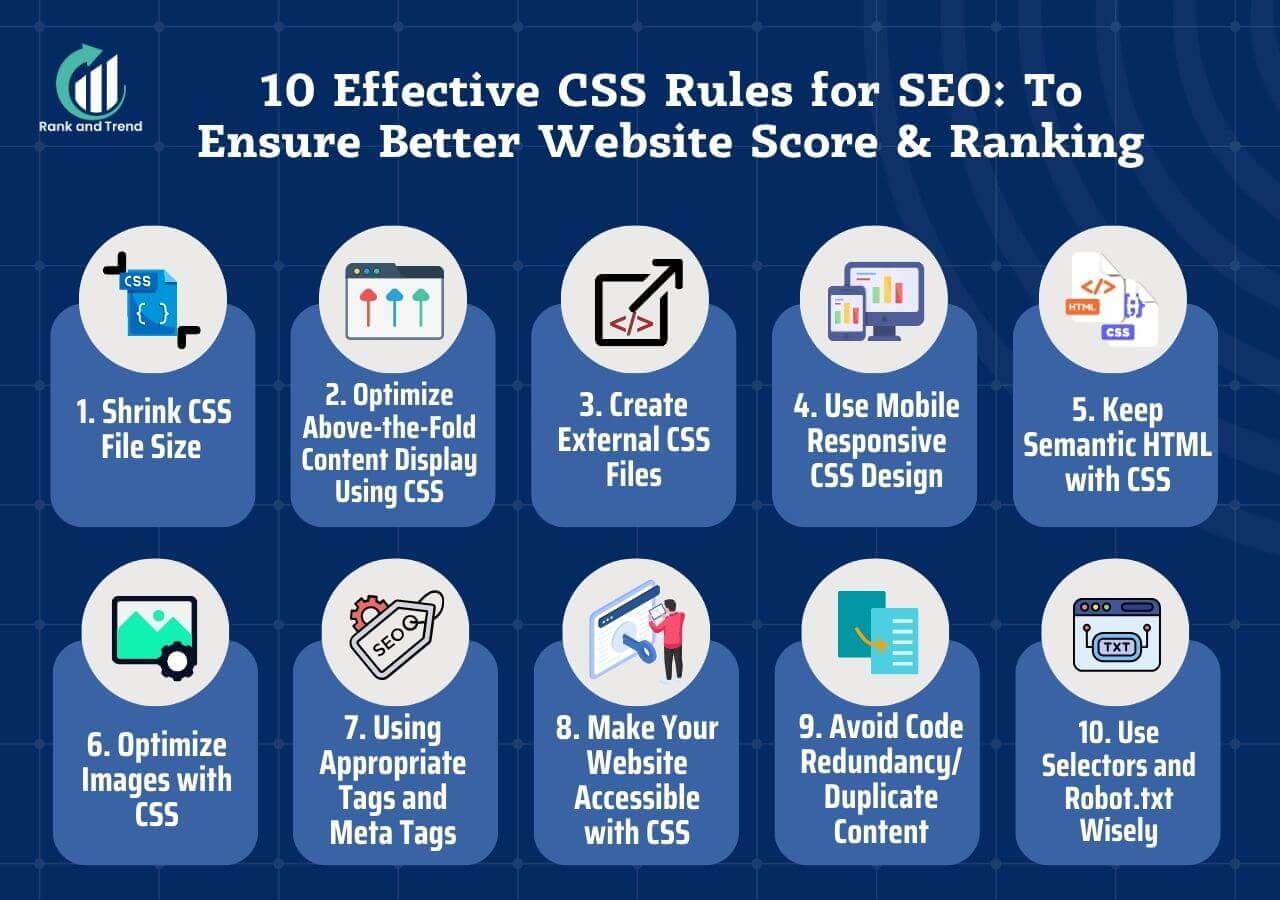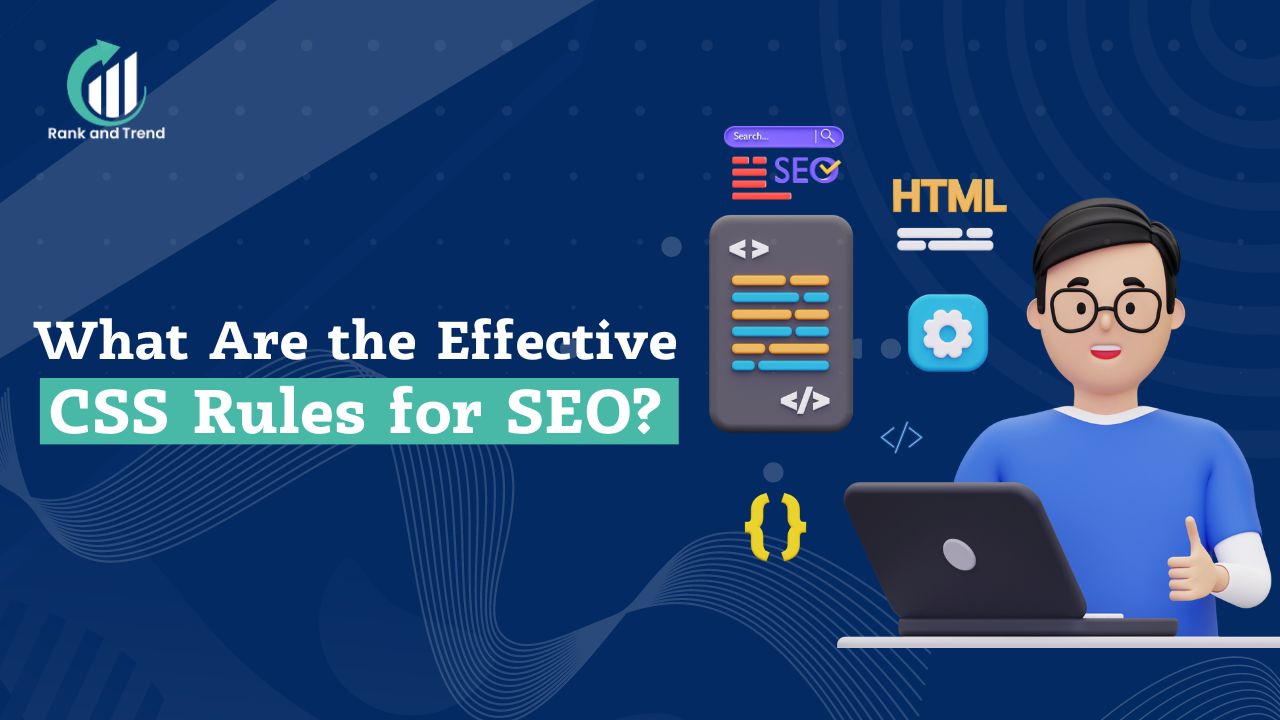CSS best practices for SEO is a common challenge for website developers and designers. So, what are the effective CSS rules for SEO?
Effective CSS rules for SEO are avoiding too much inline CSS and complex selectors. Use proper tags and prioritize responsive layouts. Keep CSS neat and minimize code for faster crawling and page loading.
You need to make it easy for the search engines to understand and index your semantic markup. Proper headings (h1, h2, etc.), optimized image alt tags, and clean, lightweight code are the CSS best practices for SEO. SEO success lies in finding a balance between lightweight code and maintaining a consistent design.
In this guide, we’ll discuss 10 CSS rules that great SEOs follow to make a website stand out. They’ll make your next website SEO-friendly to score better and rank higher. Let’s get this going, shall we?
Why CSS Is Important for SEO?
CSS, which stands for Cascading Style Sheets, significantly impacts SEO by influencing key factors in a website’s performance and user experience.

Let me break down how CSS helps with SEO:
Loading Speed
CSS plays a big role in how fast a website loads. When CSS is optimized with efficient coding, it helps the pages load faster. This is important for keeping users happy and can also make search engines view the site more positively.
User Experience (UX)
Well-structured CSS significantly improves the overall user experience on your website. Positive user experience increases average time on the site and reduces bounce rate.
Bounce rate works directly for the search engine rankings of your website. That’s why effective CSS is a vital component for successful SEO.
Mobile Responsiveness
More than 50% of search traffic comes via mobile devices, and 61% of mobile users won’t revisit a website that is not mobile friendly. On the other hand, being mobile responsive is one of the most important ranking factors for search engines.
CSS ensures your site is adaptive to any screen size. This way, CSS positively impacts SEO for good.
Aesthetics and Layout
You can control how HTML elements appear on a website, impacting its look and layout using CSS. Effective CSS creates visually appealing sites that boost user satisfaction, longer sessions, and, in turn, enhance SEO performance.
Code Optimization
Effective CSS coding is vital for SEO, requiring clean and organized code. Implementing CSS rules effectively avoids unnecessary code bloat. This leads to a streamlined website structure that helps search engine crawlers to index the site, positively impacting SEO.
Metadata and Styling
CSS styles HTML elements, including important metadata like headings, crucial for SEO. Well styled elements help search engines understand content structure, improving indexing and ranking.
In short, CSS isn’t just about looks; it’s a key factor in how search engines assess and rank a website.
10 Effective CSS Rules for SEO: To Ensure Better Website Score & Ranking

1. Shrink CSS File Size (For Faster Load Speed)
Your website’s speed is a big deal in SEO because search engines favor fast sites in the SERPs (Search Engine Result Pages).
Tweaking your CSS code can directly boost SEO of your website. Shrink your CSS file size using techniques like:
- Minification: To trim unnecessary characters.
- Compaction: This technique condenses rules for a streamlined file.
- Compression: It uses efficient encoding to further reduce size.
Automated tools like CSS Minifier or CSS Compressor simplify this process. Reducing CSS file size is vital for faster page loading, crucial for both user experience and search engine rankings. A large, optimized CSS file of 50 KB can replace a bloated 500 KB file, enhancing SEO by improving loading times and user engagement.
Here’s how you handle large CSS files if you’re coding the website from the scratch:
A smart CSS rule for speed is “background-attachment:fixed” which keeps the background image fixed instead of scrolling. It reduces the site’s size and enhances loading speed.
Besides, you can write CSS in various ways, some being quicker for crawlers while others being slower.
For instance, here’s how you’d see CSS usually:
.YourClass {
margin-left: 25px;
margin-top: 35px;
margin-right: 40px;
margin-bottom: 35px;
}However, that’s not an efficient way to write codes, since it uses more lines.
Here’s an effective version of the same CSS above:
.YourClass {
margin: 35px 40px 35px 25px; /*margin: top right bottom left;*/
}This way, you can write the same code in a single line, saving time, and making the code lightweight. And guess what’s getting better? Yes, your SEO, with a much faster load speed.
2. Optimize Above-the-Fold Content Display Using CSS
To boost website performance, prioritize above-the-fold content by inline CSS styles needed for the visible part of the page. This approach aligns with effective CSS rules for SEO, as search engines value quick delivery of critical content for improved user experience.
For example, for news websites, styling above-the-fold elements with CSS ensures vital information like headlines and images loads swiftly, optimizing the site for SEO.
Using “async” and “defer” attributes for non-essential scripts aids in this optimization process. You can use Critical Path CSS Generator or manual inline CSS tools to optimize them.
3. Create External CSS Files
Optimize CSS for SEO by creating external files instead of inline or internal CSS. External CSS files are separate and linked to HTML using the <link> tag, reducing code repetition.
This improves the code-to-content ratio, simplifies maintenance, and allows for faster page loading as external files can be cached by browsers. While inline CSS is convenient for small projects, integrating a Content Management System (CMS) and using external stylesheets is a recommended SEO practice for better search engine perception of your content.
4. Use Mobile Responsive CSS Design
Survey says, around 60% of web traffic comes from mobile devices. To provide the best user experience, ensure your website has a responsive CSS design that adapts to any device size.
Google favors sites with optimized designs for various screen sizes, leading to higher rankings. Use CSS media queries for responsive designs, adjusting content based on the device’s viewport size.
Here’s an example of CSS codes for mobile-responsive design and image scaling:
CSS for mobile menu:
@media screen and (max-width: 768px) {
.menu {
display: none; /* Hide desktop menu */
}
.mobile-menu {
display: block; /* Show mobile menu */
}
}CSS for responsive image scaling:
.img-responsive {
max-width: 100%;
height: auto;
}In this way, you can boost your website’s SEO with responsive CSS, optimizing for different screens and ranking higher on Google.
5. Keep Semantic HTML with CSS
To boost your website’s SEO, employ semantic HTML, which involves using HTML elements with clear, meaningful names and attributes.
Tags like <header>, <nav>, <article>, and <footer> convey specific section meanings to search engines when appropriately used. Apply CSS styles to these tags for both visual appeal and SEO effectiveness.
For instance, using <article> tags with CSS styles improves content readability and signals to search engines the importance of the enclosed information, potentially enhancing your rankings. Integrating semantic HTML with CSS creates well-organized, easily navigable websites that search engines quickly comprehend. This strategy improves SERP rankings and website traffic.
6. Optimize Images with CSS
Images enhance your site’s look, and CSS helps optimize them for SEO. You can use CSS to add alt tags and set dimensions, reducing file size and speeding up image loading. Imagine someone browsing your site on a phone. Without responsive design, images might be too big, causing awkward scrolling.
Responsive CSS fixes this by resizing images based on the screen, ensuring a smooth experience. Follow these six tips for effective image resizing:
- Maintain Aspect Ratio: Use CSS to keep images visually appealing.
- Use ‘max-width: 100%’: Let images adapt to screen width without overflow.
- Auto-Height: Set height to “auto” for proportional adjustments.
- Optimize for Speed: Smaller images mean faster loading, crucial for SEO.
- Consider Formats: Modern formats like WebP can enhance performance.
- Test Across Devices: Ensure images look good on all devices.
Use CSS for image dimensions in your HTML. Hide the “alt” text visually while keeping it accessible to screen readers. This speeds up your site, improving SEO.
7. Using Appropriate Tags and Meta Tags
H1 and H2 tags are vital for SEO. Optimizing H1 and H2 tags with CSS helps grab user attention, making search engines favor your site. Meta tags are bits of code that give search engines crucial details about your webpage and guide how it appears in search results.
Here are some best practices of meta tags for SEO:
- Craft unique and descriptive title tags with target keywords.
- Create concise and compelling meta descriptions to encourage clicks.
- Utilize meta robots to control indexing and follow links on the page.
- Be cautious with the meta refresh tag, as it can impact rankings and user experience.
- Specify character encoding with the meta charset tag, typically using UTF-8 for most languages.
A useful CSS rule for meta tags is “font-size: 0”, allowing you to embed them without affecting your website’s design or layout.
8. Make Your Website Accessible with CSS
ADA compliance means ensuring your website is accessible to people with disabilities. This is both a legal requirement and a good practice for SEO and user experience. CSS comes in handy by optimizing your content’s operability, highlighting elements like descriptive anchor text and “alt” tags for media files. It also provides crucial features like “skip to navigation,” ensuring equal access for everyone, and promoting ADA compliance.
Here are some CSS techniques for accessibility:
- Use proper HTML and CSS coding for easy navigation by assistive technologies.
- Include alternative text for images, aiding users with visual impairments.
- Size fonts and layouts using relative units (em, rem, %) for adjustable preferences.
- Implement keyboard navigation, focus styles, and skip links for better accessibility.
- Avoid CSS properties that hide focus indicators without providing alternatives.
9. Avoid Code Redundancy/Duplicate Content
Code redundancy means having the same or similar code in multiple places. It can eventually make CSS larger, slow down your site speed, or make it harder to manage. Repeating code snippets for the same design is common but can negatively impact your SEO rankings due to duplicate content. If your website’s content is too similar to another site, search engines may consider it spammy. To prevent this, use CSS to create unique page layouts, differentiating your site.
An effective CSS rule for this is “float:left” to arrange content visually and prevent duplicate content issues.
To further avoid redundancy, utilize reusable classes or IDs in your CSS file for consistent styling across elements. This makes the code minimal and improves loading time.
10. Use Selectors and Robot.txt Wisely
You don’t want search engine crawlers to misunderstand your website, right? Avoid blocking CSS files in Robot.txt, as it can cause layout problems during crawling, and harm your SEO.
Selectors (Classes, IDs, Attributes, or Elements) in CSS help crawlers recognize your site. Thus, avoid using complex selectors.
We recommend you use simple and clear selectors so that crawlers can easily understand your website’s structure. This ensures proper indexing of your content.
Frequently Asked Question
Can CSS Alone Boost SEO?
Well, not exactly. CSS does make your website stylish, but to boost SEO you have to combine quality content, smart keyword strategies, solid backlinks, and more.
Does CSS Negatively Affect SEO Factors?
Yep, if your CSS is all over the place, or you’re using too much of it, your site may backfire, and that’s not good for SEO. So, it’s crucial to keep your CSS game optimized and balanced.
What Role Does CSS Play in SEO?
A lot actually! CSS isn’t just about pretty designs, it plays a big role in the user experience of your site. A well designed site that loads fast? That’s a secret weapon you can achieve with CSS for climbing the ranks in search engines.
Conclusion
Alright, that’s a wrap for today! You should now know what are the effective CSS rules for SEO this year. We’ve explored effective CSS rules– like uncovering secrets for better website rankings. Think of it as fine-tuning stylesheets, reducing file sizes, and ensuring a smooth page-loading experience for the visitors.
We’ve also covered essentials like indexing, site structure, and why faster loading time matters. Remember, SEO is a continuous journey that requires consistent improvement over time. Keep your CSS practices adaptive to the latest changes in the SEO landscape. Reach out to RankandTrend if you want professional consultancy for free. We’re here to help.






